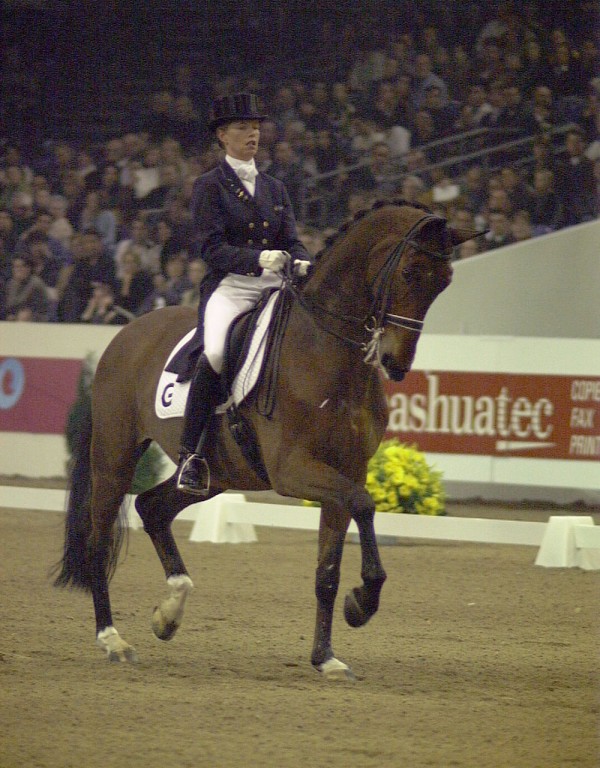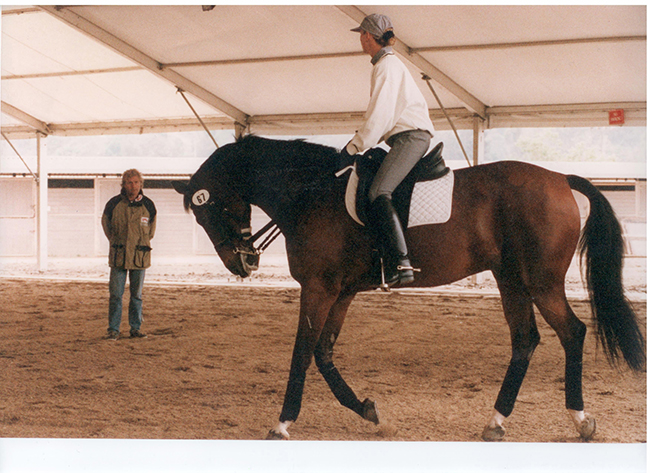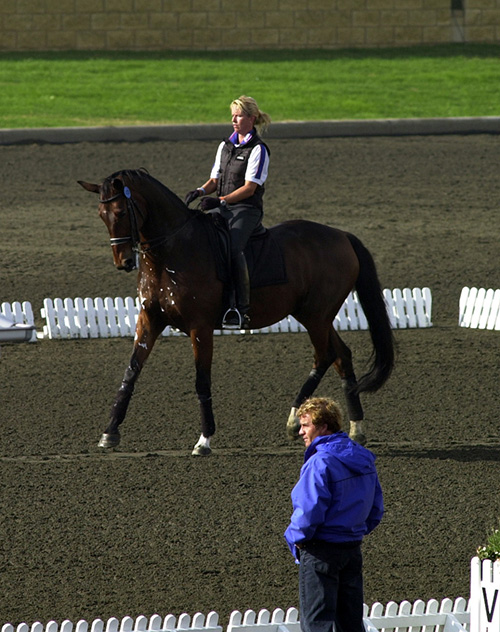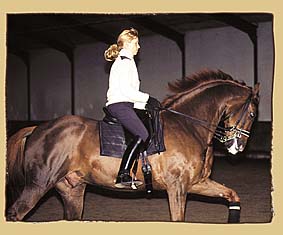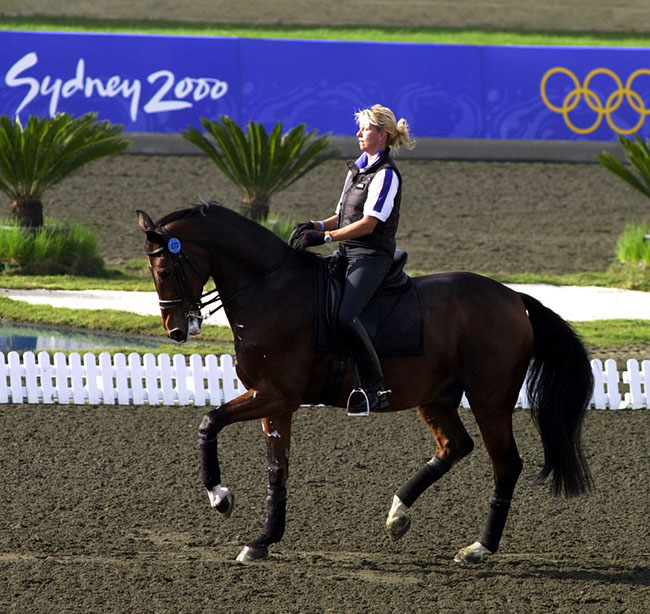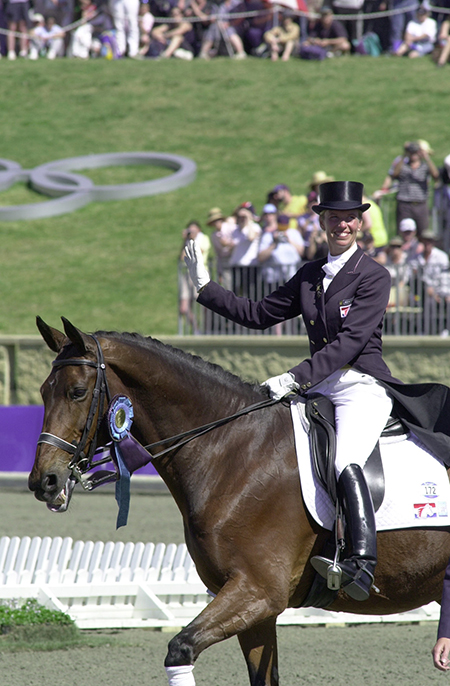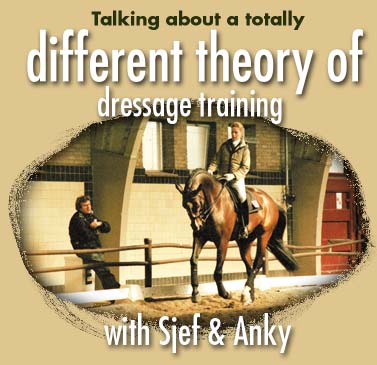
Sjef Janssen is one of the most controversial figures in international dressage. He is an outsider who set about revolutionising the sport – coming into dressage with no background in horses, he set about devising his own training program – a program that has been spectacularly successful for his partner, Anky van Grunsven, and now for their star student, Arjen Teeuwissen.
In this exclusive interview with Chris Hector, Sjef talks frankly about his radical system of training… Photos by Roz Neave.
“You have to commit yourself totally or our system doesn’t work. Our system is totally different – ours is normal. It is a totally different approach because I don’t come out of the horse world. I come from a background where sport is very important, from day one I’ve been exposed to a lot of sports people and trainers, and from that, my approach is totally different. I think the classical way of dressage training is technically good, because I use the same techniques, but the approach is different.”
“We try to get a direct approach to the horse to get a good communication, trying to understand how he behaves, and reacts to whatever you are doing. From there, you make your dressage schedule for that particular horse, because for every horse we do it differently. I think in the old method, that they still call ‘classical’, works always on the same training methods and they don’t ever change it; they only have one system, and that’s it. The horse survives, or he doesn’t – he fits in the system, and if he doesn’t they blame it on the horse: the horse is not good enough. The horse is probably good enough, but he doesn’t fit in their system, and since they only have one system, that’s it. In our system, we have many ways to get to a horse, we have many more chances to succeed.”
If you have an intelligent student who is trained in the ‘classical’ system andhe comes to you for help – what does he have to change?
“It’s very easy. In the first lesson I let them do very simple stuff, very direct. And even with very simple stuff – make a decent transition, make the horses give in, make the horse go over the back, reaction to the actions of the aids – four or five simple things, and 99 out of 100, cannot do it. Then I confront them with that, and even Grand Prix riders, cannot do it, so that convinces them that something very basic is wrong. And that’s where I want to start, to point that out – this is very simple, can you do this? No. Then you have a big problem. They realise that, and they start from scratch.”
“You have to make the decision to forget whatever you have done, and start from scratch. The technique you can keep – but when we ride something like a half pass, we do it with six less aids than all the other riders. Technically the finished result is the same, but the way to it, that’s different. They get confronted with that in the beginning and that convinces them, but to change is a long way…”
How long?
“You have to commit yourself to years and years of doing it the new way, and if you don’t want to do that, it’s ‘Goodbye, Auf Wiedersein…’ I hardly take on any students, I don’t want to do it any more – it takes too much out of you. I’ve been working with Anky for ten years and we are still studying every day, still discovering new things, still going back to basics almost every day – to put that into somebody takes so many years, and so much time. I want to do more things than that with my life…”
Your initial equestrian instruction was in an even older system – the first people you studied with were followers of Nuno Oliveira of that older way, and using those older breeds of horses – Lusitano, Lippizanner, Andalusian. What did you learn from them?
“Each of those horses had their specific thing. One was good at piaffe, one was good at passage, they had things they could do well. What I try to do with my horses, is have one horse that can do all those things in a special way, which is difficult. But what I got out of that time was a feeling for how it really should look, and how it should feel. I’m not talking about their gaits, that’s different – you have to discover that in a Warmblood, but a lot of the technical stuff – piaffe and passage, and really sitting pirouettes, blah, blah, blah – it was fantastic to get the feeling out of those horses. They supplied me with a lot of information.”
The general criticism of those schools – like Oliveira, like von Neindorff – is that they are not truly forward, they tend to sit a little behind the bit in an over-collected way, yet your horses are supremely forward?
“I agree with that, but to feel what I call ‘the tricks’ and learn how they should look, that was very good – but I also felt there was something totally missing, and that gets back to the Warmbloods again, where you work a lot more getting them through and developing the gaits. From that time I brought with me a lot of technical stuff which I then put in the basic training you normally do with the Warmbloods. I always believe that the higher a horse gets in his development and in his training, the better the gaits should get, and if the gaits get less, then something is basically very wrong in your training.”
I’ve seen in the warm up arena, if Anky feels the horse is not really forward, she will stop whatever she is doing and just gallop forward. Is that a philosophy you have developed?
“No, that’s natural, everyone does that, I hope. In everything you do, even your halts, you have to feel a forward feeling. I keep that very much in our system, our horses have so much forward impulsion, and they also listen very well to the half halt and the collections, and that makes them look very expressive. Rule number one is that they always have to think forward – so if a horse is thinking a little backwards, we solve that problem by getting them extremely thinking forwards again.”
The conventional theory is that if you let a horse work with his head behind the vertical, he learns to back off the contact, and loses his forward, but that doesn’t happen in your system because you work a lot of the time very deliberately behind the vertical?
“Behind the vertical doesn’t mean they are not on the bit. That’s completely wrong if people think that. They think the horse is behind the vertical, so he is not forward and not on the bit – that’s total bullshit. Horses can be deep and round, and even on a loose snaffle rein they can still be on the aids – if you push them a little forward then their reaction is again that they get some impulsion forward and give you some weight back in your hand. If you cannot do that immediately, then you’ve got problems. But we can also ride them very short, but we can also ride them immediately extremely long. They always follow the hand, wherever we want them.”
“Medically it has been proven in the past couple of months by professors and physiotherapists, that it is much better for the horse to ride him in a round frame, it is proven. It is better for the horse’s overall soundness, for muscles, for stretching, coping better with the work.”
You say your philosophy is to keep it simple – yet when you were working with Anky and Idool the other day, you were working on some pretty complicated flexions…
“This is a special case. He gets a different approach from other horses, and it varies from day to day even with that horse – next day we worked him very long and round. He has a natural way of stretching out his neck by himself, and not waiting on us – so we make him a little too short, and totally on the rein, to make him wait – so that he learns to stretch our way, and to our contact. So when we give him the rein he doesn’t grab but follows it very softly.”
I’ve seen you work horses down and round, but Idool was more up and in?
“We don’t do that all the time, normally we vary it a lot more with him. Lately we do this a little more because it helps, first he learns to wait, then we get him down and over the back again. He is one of those horses that needed a really different approach.”
In special cases, horses have to be ridden differently – Anky and Idool
How flexible is your approach – can you ever imagine using an over-check to lunge a horse?
“We never use stuff like that. If we lunge them, most of the time we don’t have anything on them, if we do something, we use regular side reins. Most of the time we just let them play a little bit with nothing on them.”
“You should be able to educate a horse sitting on top of him. I don’t like those things people use to hide their own short-comings.”
You never use draw reins?
“Every now and then with a younger horse – but if you saw us riding in draw reins there is a total loop in it, use it for a few seconds then they are gone again. You will never see us using a draw rein in a tight connection, it doesn’t work that way anyway. I think most people should stay away from draw reins, only the ones who really know how should use it – and then only a touch.”
Do you ever go back to any of the classical texts of dressage?
“On a regular basis I go back to my Steinbrecht, that’s the only one for me. Of course there are other good books but that’s the one I can live with a lot. There are lots of things in the book that I don’t agree with, but there are lots of good things, and the guy really thought about everything, and tried to get a system going.”
Do you think the system you and Anky have developed will spread and gain in influence – will you be thought of as the Baucher of the twentieth century?
“Whatever they do, I don’t care all that much, as long as it works for us. It sounds a little anti-social which I’m definitely not, but I don’t feel like the preacher that has to spread it all over the world. If people want to take lessons from Anky, then they can do that. It’s up to us. People have been fighting us for many many years about the system but more and more are riding like it, at least they try to copy it. If you do it correctly it would help you a lot, but I’m not going to be the one who is travelling over the world just to spread the news – I like the golf game too much.”
One of the things people say about your system is that to ride deep and round you have to be some sort of genius – that the conventional outline is somehow much easier, when really I think a less good rider can do less damage to the horse in the deep round outline….
“I think the conventional system of riding the horse up there, and precisely on the bit, causes way more problems than what we do. What we do is solve the problems. I think it would make life a lot easier for a lot of riders if they would work with the system we have, because it makes everything very simple – the horse feels better, there are less injuries, they go more over the back, they are happy using their muscles much better – you don’t need force any more. Little ladies with no power are able to ride big strong horses, the system is based on taking away all the blocks in the horse – but in the other system the horses do not feel happy any more, because you cannot ride every day in that position, it’s like every day you don’t ask a track athlete to run one hundred metres, you don’t train every day in the same position. You use gymnastics, and interval training and a lot of other stuff, to get to the 100 metres. The other system does the same thing every day in the same way, so the horse is always using the same muscles in the same way, that’s crazy because you have a million more muscles and nerves you can use. I am 200% convinced that our system is way better for the rider and the horse. The reason they say it can only work in the hands of a genius, is that they don’t understand our system.”
If someone looks at you and Anky training and decides, yes, I am going to try to train like that at home – would you give them any little warning?
“The only warning that I would give is to do it 100%, and be aware that it will take a whole lot of time, and basically you will have to stick to it, because you cannot say, ‘this is getting a bit difficult, I am going to do it the other way’ because ours is a very close knit system. Our system is based on a very big study of the basic foundations, to get that foundation built up you need a lot of time and a lot of patience and a lot of good timing – and, the most difficult part for everybody, to be consistent. That will take a lot out of you. I’ve had students and they just couldn’t do it. The wait was too long. I had Grand Prix riders who realised after a couple of months that they really had to go back to scratch, and take the time to build it up again. They said, this is going to take too long, I want to get out and compete now. I said ‘that’s okay, it’s not my problem, it’s up to you’.”
Why does it take so long to switch over to your system?
“The first thing is to learn to listen to your horse. We try to get the riders to react to things they’ve probably never felt before – when they feel, I want them to react, that’s the first step. Then they discover that they didn’t listen to their horses enough, or that their reactions were wrong. That’s the first step, after that you start working over the back and things like that, but that is the first step and you keep coming back to that. Timing is really important if you want to have a conversation with your horse, a lot of riders have terrible timing. If you can’t time, you can’t talk, if you react too late on something the horse is trying to tell you, the horse doesn’t understand the answer any more. You have to be very quick, if he presents you with something, you have to give an immediate reaction, then he can understand. If you do the ‘good’ reaction but you do it two or three seconds too late, there is no connection any more, it is very important to get the timing right, so that you can talk with each other.”
“Say you are standing still, and you want the horse to walk. If you watch a lot of riders, they put the leg on, but nothing happens for one or two seconds, so they actually teach the horse to be late to the aids. What we want is when we go to put our leg on, even before we almost touch the horse, he has to be moving already. A lot of riders don’t feel this any more, they think, I give my aid, and the horse always reacts two or three seconds later. We want an immediate reaction; we train a lot of transitions and you need very good timing, pat him immediately and say this was good – or tell him that it was wrong, you didn’t react. Immediately he starts moving, even if it is an inch, you’ve got to pat him already, we are talking now splits of seconds – if you pat one second too late, or a lot of people pat ten metres too late, then you have a basic problem.”
“You must remember that horses are very simple animals. They are not as intelligent as us, yet a lot of people approach horses as if they were as intelligent as us – horses cannot understand what we think, that’s ridiculous, so we have to tell them bit-by-bit what we think – and we can only teach them what they are physically and mentally capable of doing – if you overstretch that, then you write yourself into the bullshit.”
“A lot of it is mental training, which I love, even now with Anky, 60-70% of what we do is mental training to the horse, and vice versa.”
Do you still enjoy working with horses, or is it just another day in the office, and you would prefer to be playing golf?
“No, I love working with horses. I don’t think I’ve ever had one day since I started working with horses, that I went to the stables, and didn’t want to get going… I always look forward to it. First of all, I am working with Anky. Secondly, we have a string of horses and a lot of them are really good – I love to see it when they start from scratch, and then through the years they grow up, then they become Grand Prix horses, and maybe even a very good Grand Prix horses. It is just fantastic to work along that line, and see it happen. I just love to watch the horse come from nothing and then to go out and be splendid, people are sitting in the crowd, and if you ride a good pirouette, super music, or whatever, and they get tears in their eyes, that’s it, that’s what you do it for.”
This story first appeared in the July 2000 edition of The Horse Magazine



